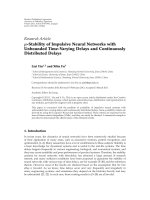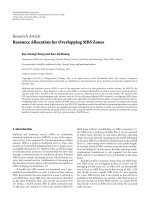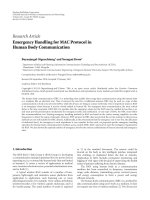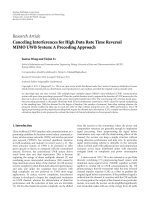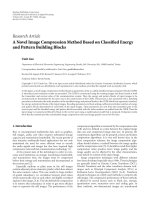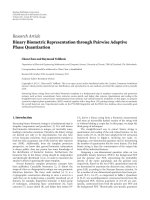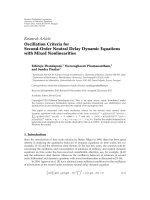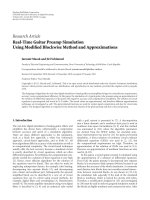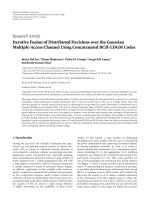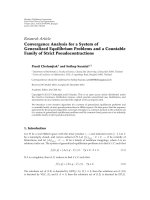báo cáo hóa học:" Research Article Iterative Algorithms for Finding Common Solutions to Variational Inclusion Equilibrium and Fixed Point Problems" ppt
Bạn đang xem bản rút gọn của tài liệu. Xem và tải ngay bản đầy đủ của tài liệu tại đây (530.14 KB, 17 trang )
Hindawi Publishing Corporation
Fixed Point Theory and Applications
Volume 2011, Article ID 915629, 17 pages
doi:10.1155/2011/915629
Research Article
Iterative Algorithms for Finding Common
Solutions to Variational Inclusion Equilibrium and
Fixed Point Problems
J. F. Tan and S. S. Chang
Department of Mathematics, Yibin University, Yibin, Sichuan 644007, China
Correspondence should be addressed to S. S. Chang,
Received 30 October 2010; Accepted 9 November 2010
Academic Editor: Qamrul Hasan Ansari
Copyright q 2011 J. F. Tan and S. S. Chang. This is an open access article distributed under the
Creative Commons Attribution License, which permits unrestricted use, distribution, and
reproduction in any medium, provided the original work is properly cited.
The main purpose of this paper is to introduce an explicit iterative algorithm to study the existence
problem and the approximation problem of solution to the quadratic minimization problem.
Under suitable conditions, some strong convergence theorems for a family of nonexpansive
mappings are proved. The results presented in the paper improve and extend the corresponding
results announced by some authors.
1. Introduction
Throughout this paper, we assume that H is a real Hilbert space with inner product ·, · and
norm ·, C is a nonempty closed convex subset of H,andFT{x ∈ H : Tx x} is the
setoffixedpointsofmappingT.
A mapping S : C → C is called nonexpansive if
Sx − Sy
≤
x − y
, ∀x, y ∈ C. 1.1
Let A : H → H be a single-valued nonlenear mapping and M : H → 2
H
be a
multivalued mapping. The so-called quasivariational inclusion problem see 1–3 is to find
u ∈ H such that
θ ∈ A
u
M
u
. 1.2
The set of solutions to quasivariational inclusion problem 1.2 is denoted by VIH, A, M.
2 Fixed Point Theory and Applications
Special Cases
I If M ∂φ : H → 2
H
,whereφ : H → ∪{∞} is a proper convex lower semi-continuous
function and ∂φ is the subdifferential of φ, then the quasivariational inclusion problem 1.2
is equivalent to finding u ∈ H such that
A
u
,y− u φ
y
− φ
u
≥ 0, ∀y ∈ H, 1.3
which is called the mixed quasivariational inequality see 4.
II If M ∂δ
C
,whereC is a nonempty closed convex subset of H and δ
C
: H →
0, ∞ is the indicator function of C,thatis,
δ
C
x
⎧
⎨
⎩
0,x∈ C,
∞,x
/
∈ C,
1.4
then the quasivariational inclusion problem 1.2 is equivalent to finding u ∈ C such that
A
u
,v− u
≥ 0, ∀v ∈ C. 1.5
This problem is called the Hartman-Stampacchia variational inequality see 5.Thesetof
solutions to variational inequality 1.5 is denoted by VIA, C.
Let B : C → H be a nonlinear mapping and F : C × C →
be a bifunction. The
so-called generalized equilibrium problem is to find a point u ∈ C such that
F
u, y
B
u
,y− u
≥ 0, ∀y ∈ C. 1.6
The set of solutions to 1.6 is denoted by GEP see 5, 6.IfB 0, then 1.6 reduces to the
following equilibrium problem: to find u ∈ C such that
F
u, y
≥ 0, ∀y ∈ C. 1.7
The set of solutions to 1.7 is denoted by EP.
Iterative methods for nonexpansive mappings and equilibrium problems have been
applied to solve convex minimization problems see 7–9. A typical problem is to minimize
a quadratic function over the set of the fixed points of a nonexpansive mapping on a real
Hilbert space H:
min
x∈F
1
2
x
2
,
1.8
where F is the fixed point set of a nonexpansive mapping T on H.
In 2010, Zhang et al. see 10 proposed the following iteration method for variational
inclusion problem 1.5 and equilibrium problem 1.6 in a Hilbert space H:
x
t
SP
C
1 − t
J
M,λ
I − λA
T
μ
I − μB
x
t
,t∈
0, 1
. 1.9
Fixed Point Theory and Applications 3
Under suitable conditions, they proved the sequence {x
n
} generated by 1.9 converges
strongly to the fixed point x
∗
, which solves the quadratic minimization problem 1.8.
Motivated and inspired by the researches going on in this direction, especially inspired
by Zhang et al. 10, the purpose of this paper is to introduce an explicit iterative algorithm
to studying the existence problem and the approximation problem of the solution to the
quadratic minimization problem 1.8 and prove some strong convergence theorems for a
family of nonexpansive mappings in the setting of Hilbert spaces.
2. Preliminaries
Let H be a real Hilbert space, and C be a nonempty closed convex subset of H.Foranyx ∈ H,
there exists a unique nearest point in C, denoted by P
C
x,suchthat
x − P
C
x
≤
x − y
, ∀y ∈ C. 2.1
Such a mapping P
C
from H onto C is called the metric projection. It is well-known that the
metric projection P
C
: H → C is nonexpansive.
In the sequel, we use x
n
xand x
n
→ x to denote the weak convergence and the
strong convergence of the sequence {x
n
}, respectively.
Definition 2 .1. A mapping A : H → H is called α-inverse strongly monotone if there exists
an α>0suchthat
Ax − Ay, x − y
≥ α
Ax − Ay
2
, ∀x, y ∈ H.
2.2
A multivalued mapping M : H → 2
H
is called monotone if ∀x, y ∈ H, u ∈ Mx, v ∈ My,
u − v, x − y
≥ 0. 2.3
A multivalued mapping M : H → 2
H
is called maximal monotone if it is monotone and for
any x, u ∈ H × H,when
u − v, x − y
≥ 0 for every
y, v
∈ Graph
M
, 2.4
then u ∈ Mx.
Proposition 2.2 see 11. Let A : H → H be an α-inverse strongly monotone mapping. Then,
the following statements hold:
i A is an 1/α-Lipschitz continuous and monotone mapping;
ii if λ is any constant in 0, 2α, then the mapping I − λA is nonexpansive, wher e I is the
identity mapping on H.
4 Fixed Point Theory and Applications
Lemma 2.3 see 12. Let X be a strictly convex Banach space, C be a closed convex subset of X,
and {T
n
: C → C} be a sequence of nonexpansive mappings. Suppose
∞
n1
FT
n
/
∅.Let{λ
n
} be a
sequence of positive numbers with Σ
∞
n1
λ
n
1. Then the mapping S : C → C defined by
Sx Σ
∞
n1
λ
n
T
n
x, x ∈ C 2.5
is well defined. And it is nonexpansive and
F
S
∞
n1
F
T
n
.
2.6
Definition 2.4. Let H be a Hilbert space and M : H → 2
H
be a multivalued maximal
monotone mapping. Then, the single-valued mapping J
M,λ
: H → H defined by
J
M,λ
u
I λM
−1
u
,u∈ H
2.7
is called the resolvent operator associated with M,whereλ is any positive number and I is the
identity mapping.
Proposition 2.5 see 11. i The resolvent operator J
M,λ
associated with M is single-valued and
nonexpansive for all λ>0,thatis,
J
M,λ
x
− J
M,λ
y
≤
x − y
, ∀x, y ∈ H, ∀λ>0. 2.8
ii The resolvent operator J
M,λ
is 1-inverse strongly monotone, that is,
J
M,λ
x − J
M,λ
y
2
≤
x − y, J
M,λ
x
− J
M,λ
y
, ∀x, y ∈ H.
2.9
Definition 2.6. A single-valued mapping A : H → H is said to be hemicontinuous if for any
x, y, z ∈ H,functiont →Ax ty,z is continuous at 0.
It is well-known that every continuous mapping must be hemicontinuous.
Lemma 2.7 see 13. Let {x
n
} and {y
n
} be bounded sequences in a Banach space X.Let{β
n
} be a
sequence in 0, 1 with
0 < lim inf
n →∞
β
n
≤ lim sup
n →∞
β
n
< 1.
2.10
Suppose that
x
n1
1 − β
n
y
n
β
n
x
n
, ∀n ≥ 0,
lim sup
n →∞
y
n1
− y
n
−
x
n1
− x
n
≤ 0.
2.11
Fixed Point Theory and Applications 5
Then,
lim
n →∞
y
n
− x
n
0.
2.12
Lemma 2.8 see 14. Let X be a real Banach space, X
∗
be the dual space of X, T : X → 2
X
∗
be a
maximal monotone mapping, and P : X → X
∗
be a hemicontinuous bound monotone mapping with
DP X. Then, the mapping S T P : X → 2
X
∗
is a maximal monotone mapping.
Lemma 2.9 see 15. Let X be a uniformly convex Banach space, let C be a nonempty closed convex
subset of X,andT : C → C be a nonexpansive mapping with a fixed point. Then, I − T is demiclosed
in the sense that if {x
n
} is a sequence in C satisfying
x
n
x,
I − T
n
−→ 0, 2.13
then
I − T
x 0 . 2.14
Throughout this paper, we assume that the bifunction F : C × C →
satisfies the
following conditions:
H
1
Fx, x0forallx ∈ C;
H
2
F is monotone, that is,
F
x, y
F
y, x
≤ 0, ∀x, y ∈ C, 2.15
H
3
for each x, y, z ∈ C,
lim
t↓0
F
tz
1 − t
x, y
≤ F
x, y
,
2.16
H
4
for each x ∈ C, y → Fx, y is convex and lower semi-continuous.
Lemma 2.10 see 16. Let H be a real Hilbert space, C be a nonempty closed convex subset of H,
and F : C × C →
be a bifunction satisfying the conditions (H
1
)–(H
4
). Let μ>0 and x ∈ H.Then,
there exists a point z ∈ C such that
F
z, y
1
μ
y − z, z − x
≥ 0, ∀y ∈ C.
2.17
Moreover, if T
μ
: H → C is a mapping defined by
T
μ
x
z ∈ C : F
z, y
1
μ
y − z, z − x
≥ 0, ∀y ∈ C
,x∈ H,
2.18
then the following results hold:
6 Fixed Point Theory and Applications
i T
μ
is single-valued and firmly nonexpansive, that is, for any x, y ∈ H,
T
μ
x − T
μ
y
2
≤
T
μ
x − T
μ
y, x − y
,
2.19
ii EP is closed and convex, and EP FT
μ
.
Lemma 2.11. isee 11 u ∈ H is a solution of variational inclusion 1.2 ifandonlyif
u J
M,λ
u − λAu
, ∀λ>0, 2.20
that is,
VI
H, A, M
F
J
M,λ
u − λAu
, ∀λ>0. 2.21
iisee 10 u ∈ C is a solution of generalized equilibrium problem 1.6 if and only if
u T
μ
u − μBu
, ∀μ>0, 2.22
that is,
GEP F
T
μ
u − μBu
, ∀μ>0. 2.23
iiisee 10 Let A : H → H be an α-inverse strongly monotone mapping and B : C → H
be a β-inverse strongly monotone mapping. If λ ∈ 0, 2α and μ ∈ 0, 2β,thenVIH, A, M is a
closed convex subset in H and GEP is a closed convex subset in C.
Lemma 2.12 see 17. Assume that {a
n
} is a sequence of nonnegative real numbers such that
a
n1
≤ 1 − γ
n
a
n
δ
n
, ∀n ≥ 1, 2.24
where {γ
n
} is a sequence in 0, 1 and {δ
n
} is a sequence such that:
i
∞
n1
γ
n
∞;
ii lim sup
n →∞
δ
n
/γ
n
≤ 0 or
∞
n1
|δ
n
| < ∞.
Then, lim
n →∞
a
n
0.
3. Main Results
Theorem 3.1. Let H be a real Hilbert space, C be a nonempty closed convex subset of H, A : H → H
be an α-inverse strongly monotone mapping and B : C → H be a β-inverse strongly monotone
Fixed Point Theory and Applications 7
mapping. Let M : H → 2
H
be a maximal monotone mapping, {T
n
: C → C} be a sequence of
nonexpansive mappings with
∞
n1
FT
n
/
∅, S : C → C be the nonexpansive mapping defined by
2.5,andF : C × C →
be a bifunction satisfying conditions (H
1
)–(H
4
). Let {x
n
} be the sequence
defined by
x
n1
α
n
x
n
1 − α
n
SP
C
1 − t
n
J
M,λ
I − λA
T
μ
I − μB
x
n
, 3.1
where the mapping T
μ
: H → C is defined by 2.18,andλ, μ are two constants with λ ∈ 0, 2α,μ∈
0, 2β,and
t
n
∈
0, 1
,t
n
−→ 0
n −→ ∞
,
∞
n1
t
n
∞, 0 <a<α
n
<b<1.
3.2
If
Ω : F
S
∩ VI
H, A, M
∩ GEP
/
∅, 3.3
where VI H, A, M and GEP is the set of solutions of variational inclusion 1.2 and generalized
equilibrium problem 1.6, respectively, then the sequence {x
n
} defined by 3.1 converges strongly to
x
∗
∈ Ω, which is the unique solution of the following quadratic minimization problem:
x
∗
2
min
x∈Ω
x
2
.
3.4
Proof. We divide the proof of Theorem 3 .1 into four steps.
Step 1 The sequence {x
n
} is bounded.Set
u
n
T
μ
I − μB
x
n
,y
n
J
M,λ
I − λA
u
n
,z
n
SP
C
1 − t
n
y
n
. 3.5
Taking z ∈ Ω, then it follows from Lemma 2.11 that
z T
μ
z − μBz
J
M,λ
z − λAz
SP
C
z. 3.6
Since both T
μ
and J
M,λ
are nonexpansive, A and B are α-inverse strongly monotone and β-
inverse strongly monotone, respectively, from Proposition 2.2,wehave
8 Fixed Point Theory and Applications
u
n
− z
2
T
μ
I − μBx
n
− T
μ
z − μBz
2
≤
I − μBx
n
− z − μBz
2
≤
x
n
− z
2
μ
μ − 2β
Bx
n
− Bz
2
,
3.7
y
n
− z
2
J
M,λ
I − λAu
n
− J
M,λ
z − λAz
2
≤
I − λAu
n
− z − λAz
2
≤
u
n
− z
2
λ
λ − 2α
Au
n
− Az
2
≤
x
n
− z
2
λ
λ − 2α
Au
n
− Az
2
μ
μ − 2β
Bx
n
− Bz
2
.
3.8
This implies that
y
n
− z
≤
u
n
− z
≤
x
n
− z
. 3.9
It follows from 3.1 and 3.9 that
x
n1
− z
α
n
x
n
1 − α
n
SP
C
1 − t
n
y
n
− z
α
n
x
n
− z
1 − α
n
SP
C
1 − t
n
y
n
− SP
C
z
≤ α
n
x
n
− z
1 − α
n
SP
C
1 − t
n
y
n
− SP
C
z
≤ α
n
x
n
− z
1 − α
n
1 − t
n
y
n
− z
≤ α
n
x
n
− z
1 − α
n
1 − t
n
y
n
− z
t
n
z
≤ α
n
x
n
− z
1 − α
n
1 − t
n
x
n
− z
t
n
z
≤
1 − t
n
1 − α
n
x
n
− z
t
n
1 − α
n
z
≤ max
{
x
n
− z
,
z
}
≤ max
{
x
n−1
− z
,
z
}
≤···≤max
{
x
1
− z
,
z
}
M,
3.10
where M max{x
1
− z, z}. This shows that {x
n
} is bounded. Hence, it follows from 3.9
that the sequence {u
n
} and {y
n
} are also bounded.
It follows from 3.5, 3.6,and3.9 that
z
n
− z
SP
C
1 − t
n
y
n
− SP
C
z
≤
1 − t
n
y
n
− z
≤
1 − t
n
y
n
− z
t
n
z
≤
1 − t
n
x
n
− z
t
n
z
≤ M.
3.11
This shows that {z
n
} is bounded.
Fixed Point Theory and Applications 9
Step 2. Now, we prove that
lim
n →∞
x
n
− u
n
lim
n →∞
u
n
− y
n
lim
n →∞
x
n
− y
n
0,
lim
n →∞
x
n
− Sx
n
0.
3.12
Since SP
C
is nonexpansive, from 3.5 and 3.9,wehavethat
y
n1
− y
n
≤
u
n1
− u
n
≤
x
n1
− x
n
, 3.13
z
n1
− z
n
SP
C
1 − t
n1
y
n1
− SP
C
1 − t
n
y
n
≤
1 − t
n1
y
n1
−
1 − t
n
y
n
1 − t
n1
y
n1
− y
n
1 − t
n1
−
1 − t
n
y
n
≤
1 − t
n1
y
n1
− y
n
|
t
n1
− t
n
|
y
n
≤
y
n1
− y
n
|
t
n1
− t
n
|
y
n
≤
u
n1
− u
n
|
t
n1
− t
n
|
y
n
≤
x
n1
− x
n
|
t
n1
− t
n
|
y
n
.
3.14
Let n →∞in 3.14, in view of condition t
n
→ 0n →∞,wehave
lim
n →∞
z
n1
− z
n
−
x
n1
− x
n
0.
3.15
By virtue of Lemma 2.7,wehave
lim
n →∞
x
n
− z
n
0.
3.16
This implies that
lim
n →∞
x
n1
− x
n
lim
n →∞
1 − α
n
z
n
− x
n
0.
3.17
10 Fixed Point Theory and Applications
We derive from 3.17 that
lim
n →∞
x
n
− z
2
−
x
n1
− z
2
lim
n →∞
x
n
− x
n1
2
2
x
n
− x
n1
,x
n1
− z
≤ lim
n →∞
x
n
− x
n1
2
2
x
n
− x
n1
·
x
n1
− z
0.
3.18
From 3.1 and 3.8,wehave
x
n1
− z
2
≤
α
n
x
n
− z
1 − α
n
1 − t
n
y
n
− z
2
≤ α
n
x
n
− z
2
1 − α
n
1 − t
n
y
n
− z − t
n
z
2
α
n
x
n
− z
2
1 − α
n
1 − t
n
2
y
n
− z
2
− 2t
n
1 − t
n
z, y
n
− z
t
2
n
z
2
≤ α
n
x
n
− z
2
1 − α
n
y
n
− z
2
t
n
M
1
≤ α
n
x
n
− z
2
1 − α
n
×
x
n
− z
2
λ
λ − 2α
Au
n
− Az
2
μ
μ − 2β
Bx
n
− Bz
2
t
n
M
1
x
n
− z
2
1 − α
n
λ
λ − 2α
Au
n
− Az
2
μ
μ − 2β
Bx
n
− Bz
2
t
n
M
1
,
3.19
where
M
1
sup
n
z
2
2
λ
u
n
− y
n
μ
x
n
− y
n
< ∞,
3.20
that is,
1 − α
n
λ
2α − λ
Au
n
− Az
2
μ
2β − μ
Bx
n
− Bz
2
≤
x
n
− z
2
−
x
n1
− z
2
1 − α
n
t
n
M
1
.
3.21
Let n →∞, noting the assumptions that λ ∈ 0, 2α, μ ∈ 0, 2β,from3.2 and 3.18,we
have
lim
n →∞
Au
n
− Az
lim
n →∞
Bx
n
− Bz
0.
3.22
Fixed Point Theory and Applications 11
By virtue of Lemma 2.10i and 3.1,wehave
u
n
− z
2
T
μ
x
n
− μBx
n
− T
μ
z − μBz
2
≤
x
n
− μBx
n
−
z − μBz
,u
n
− z
1
2
x
n
− μBx
n
−
z − μBz
2
u
n
− z
2
−
x
n
− z
− μ
Bx
n
− Bz
−
u
n
− z
2
≤
1
2
x
n
− z
2
u
n
− z
2
−
x
n
− u
n
− μ
Bx
n
− Bz
2
1
2
x
n
− z
2
u
n
− z
2
−
x
n
− u
n
2
2μ
x
n
− u
n
,Bx
n
− Bz
− μ
2
Bx
n
− Bz
2
.
3.23
Simplifying it, we have
u
n
− z
2
≤
x
n
− z
2
−
x
n
− u
n
2
2μx
n
− u
n
,Bx
n
− Bz−μ
2
Bx
n
− Bz
2
≤
x
n
− z
2
−
x
n
− u
n
2
2μ
x
n
− u
n
·
Bx
n
− Bz
≤
x
n
− z
2
−
x
n
− u
n
2
M
1
Bx
n
− Bz
.
3.24
Similarly, in view of Proposition 2.5ii and 3.1,wehave
y
n
− z
2
J
M,λ
u
n
− λAu
n
− J
M,λ
z − λAz
2
≤
u
n
− λAu
n
−
z − λAz
,y
n
− z
1
2
u
n
− λAu
n
− z − λAz
2
y
n
− z
2
−
u
n
− λAu
n
− z − λAz − y
n
− z
2
≤
1
2
u
n
− z
2
y
n
− z
2
−
u
n
− y
n
− λAu
n
− Az
2
1
2
u
n
− z
2
y
n
− z
2
−
u
n
− y
n
2
2λ
u
n
− y
n
,Au
n
− Az
− λ
2
Au
n
− Az
2
.
3.25
12 Fixed Point Theory and Applications
Simplifying it, from 3.24,wehave
y
n
− z
2
≤
u
n
− z
2
−
u
n
− y
n
2
2λu
n
− y
n
,Au
n
− Az−λ
2
Au
n
− Az
2
≤
u
n
− z
2
−
u
n
− y
n
2
2λ
u
n
− y
n
·
Au
n
− Az
≤
x
n
− z
2
−
x
n
− u
n
2
M
1
Bx
n
− Bz
−
u
n
− y
n
2
M
1
Au
n
− Az
.
3.26
From 3.19 and 3.26,wehave
x
n1
− z
2
≤ α
n
x
n
− z
2
1 − α
n
y
n
− z
2
t
n
M
1
≤ α
n
x
n
− z
2
1 − α
n
×
x
n
− z
2
−
x
n
− u
n
2
−
u
n
− y
n
2
M
1
Bx
n
− Bz
Au
n
− Az
t
n
x
n
− z
2
1 − α
n
×
M
1
Bx
n
− Bz
Au
n
− Az
t
n
−
x
n
− u
n
2
−
u
n
− y
n
2
.
3.27
Let n →∞nd in view of 3.18 and 3.22,wehave
lim
n →∞
x
n
− u
n
2
u
n
− y
n
2
0.
3.28
This shows that
lim
n →∞
x
n
− u
n
lim
n →∞
u
n
− y
n
0,
lim
n →∞
x
n
− y
n
0.
3.29
Then, we have
x
n1
− Sx
n1
x
n1
− Sx
n
Sx
n
− Sx
n1
≤
x
n1
− Sx
n
Sx
n
− Sx
n1
SP
C
1 − t
n
y
n
− SP
C
x
n
Sx
n
− Sx
n1
≤
1 − t
n
y
n
− x
n
t
n
x
n
x
n
− x
n1
−→ 0
n −→ ∞
.
3.30
Fixed Point Theory and Applications 13
Step 3 sequence {x
n
} converges strongly to x
∗
∈ Ω.Because{x
n
} is bounded, without loss
of generality, we can assume that x
n
x
∗
∈ H.Inviewof3.12, it yields that u
n
x
∗
and
y
n
x
∗
.FromLemma 2.9 and 3.30, we know that x
∗
∈ FS.
Next, we prove that x
∗
∈ GEP ∩ VIH, A, M.
Since u
n
T
μ
x
n
− μBx
n
,wehave
F
u
n
,y
1
μ
y − u
n
,u
n
−
x
n
− μBx
n
≥ 0, ∀y ∈ C.
3.31
It follows from condition H
2
that
1
μ
y − u
n
,u
n
−
x
n
− μBx
n
≥ F
y, u
n
, ∀y ∈ C.
3.32
Therefore,
y − u
n
,
u
n
− x
n
μ
Bx
n
≥ F
y, u
n
, ∀y ∈ C.
3.33
For any t ∈ 0, 1 and y ∈ C,theny
t
ty 1 − tx
∗
∈ C.From3.33,wehave
y
t
− u
n
,By
t
≥y
t
− u
n
,By
t
−
y
t
− u
n
,
u
n
− x
n
μ
Bx
n
F
y
t
,u
n
y
t
− u
m
,By
t
− Bu
m
y
t
− u
n
,Bu
n
− Bx
n
−
y
t
− u
n
,
u
n
− x
n
μ
F
y
t
,u
n
.
3.34
Since B is β-inverse strongly monotone, from Proposition 2.2i and 3.12,wehave
Bu
n
− Bx
n
≤
1
β
u
n
− x
n
−→ 0
n −→ ∞
,
y
t
− u
n
,By
t
− Bu
n
≥ β
By
t
− Bu
n
2
≥ 0.
3.35
Let n →∞in 3.34, in view of condition H
4
and u
n
x
∗
,wehave
y
t
− x
∗
,By
t
≥F
y
t
,x
∗
. 3.36
It follows from conditions H
1
, H
4
and 3.36 that
0 F
y
t
,y
t
≤ tF
y
t
,y
1 − t
F
y
t
,x
∗
≤ tF
y
t
,y
1 − t
y
t
− x
∗
,By
t
tF
y
t
,y
1 − t
t
y − x
∗
,By
t
,
3.37
14 Fixed Point Theory and Applications
that is,
0 ≤ F
y
t
,y
1 − t
y − x
∗
,By
t
. 3.38
Let t to 0 in 3.38,wehave
F
x
∗
,y
y − x
∗
,Bx
∗
≥ 0, ∀y ∈ C. 3.39
This shows that x
∗
∈ GEP.
Step 4 now, we prove that x
∗
∈ VIH, A, M.SinceA is α-inverse strongly monotone, from
Proposition 2.2 i, we know that A is an 1/α-Lipschitz continuous and monotone mapping
and DAH,whereDA is the domain of A. It follows from L emma 2.8 that M A is
maximal monotone. Let v, f ∈ GraphM A,thatis,f − Av ∈ Mv.Sincey
n
J
M,λ
u
n
−
λAu
n
,wehaveu
n
− λAu
n
∈ I λMy
n
,thatis,1/λu
n
− y
n
− λAu
n
∈ My
n
.Byvirtue
of the maximal monotonicity of M,wehave
v − y
n
,f − Av −
1
λ
u
n
− y
n
− λAu
n
≥ 0. 3.40
Therefore we have
v − y
n
,f≥
v − y
n
,Av
1
λ
u
n
− y
n
− λAu
n
v − y
n
,Av− Ay
n
Ay
n
− Au
n
1
λ
u
n
− y
n
.
3.41
Since A is monotone, this implies that
v − y
n
,f
≥ 0
v − y
n
,Ay
n
− Au
n
v − y
n
,
1
λ
u
n
− y
n
.
3.42
Since
u
n
− y
n
−→ 0,
Au
n
− Ay
n
−→ 0,y
n
x
∗
,
n −→ ∞
, 3.43
from 3.42,wehave
lim
n →∞
v − y
n
,f
v − x
∗
,f
≥ 0.
3.44
Since A M is maximal monotone, θ ∈ M Ax
∗
,thatis,x
∗
∈ VIH, M, A.
Fixed Point Theory and Applications 15
Summing up the above arguments, we have proved that
x
∗
∈ Ω : F
S
∩ VI
H, M, A
∩ GEP. 3.45
On the other hand, for any z ∈ Ω,wehave
z
n
− z
2
SP
C
1 − t
n
y
n
− SP
C
z
2
≤
1 − t
n
y
n
− z
2
y
n
− z − t
n
y
n
2
y
n
− z
2
− 2t
n
y
n
,y
n
− z t
2
n
y
n
2
y
n
− z
2
− 2t
n
y
n
− z, y
n
− z−2t
n
z, y
n
− z t
2
n
y
n
2
1 − 2t
n
y
n
− z
2
2t
n
z, z − y
n
t
2
n
y
n
2
≤
1 − 2t
n
x
n
− z
2
2t
n
z, z − y
n
t
2
n
y
n
2
,
3.46
and so we have
x
n1
− z
2
α
n
x
n
− z1 − α
n
z
n
− z
2
≤ α
n
x
n
− z
2
1 − α
n
1 − 2t
n
x
n
− z
2
2t
n
z, z − y
n
t
2
n
y
n
2
1 − 2t
n
1 − α
n
x
n
− z
2
2
1 − α
n
t
n
z, z − y
n
t
2
n
y
n
2
≤
1 − 2t
n
1 − b
x
n
− z
2
2
1 − α
n
t
n
z, z − y
n
t
2
n
y
n
2
.
3.47
Put z x
∗
in 3.47,wehave
x
n1
− x
∗
2
≤
1 − γ
n
x
n
− x
∗
2
δ
n
,
3.48
where γ
n
2t
n
1 − b and δ
n
21 − α
n
t
n
x
∗
,x
∗
− y
n
t
2
n
y
n
2
.Sincey
n
x
∗
,itiseasyto
see that
∞
n1
γ
n
∞ and lim
n →∞
δ
n
/γ
n
0. By Lemma 2.12,weconcludethatx
n
→ x
∗
as
n →∞,wherex
∗
is the unique solution of the following quadratic minimization problem:
x
∗
2
min
x∈Ω
x
2
.
3.49
This completes the proof of Theorem 3.1.
In Theorem 3 .1,ifT T
n
∀n ≥ 1, then the following corollary can be obtained
immediately.
Corollary 3.2. Let H be a real Hilbert space, C be a nonempty closed convex subset of H, A : H →
H be an α-inverse strongly monotone mapping and B : C → H be a β-inverse strongly monotone
mapping. Let M : H → 2
H
be a maximal monotone mapping, {T : C → C} be a nonexpansive
16 Fixed Point Theory and Applications
mappings with FT
/
∅.LetF : C × C →
be a bifunction satisfying conditions (H
1
)–(H
4
). Let
{x
n
} be the sequence defined by
x
n1
α
n
x
n
1 − α
n
TP
C
1 − t
n
J
M,λ
I − λA
T
μ
I − μB
x
n
3.50
where the mapping T
μ
: H → C is defined by 2.18,andλ, μ are two constants with λ ∈ 0, 2α,μ∈
0, 2β,and
t
n
∈
0, 1
,t
n
−→ 0
n −→ ∞
,
∞
n1
t
n
∞, 0 <a<α
n
<b<1.
3.51
If
Ω
1
: F
T
∩ VI
H, A, M
∩ GEP
/
∅, 3.52
where VI H, A, M and GEP are the sets of solutions of variational inclusion 1.2 and generalized
equilibrium problem 1.6, then the sequence {x
n
} defined by 3.50 converges strongly to x
∗
∈ Ω
1
,
which is the unique solution of the following quadratic minimization problem:
x
∗
2
min
x∈Ω
1
x
2
.
3.53
In Theorem 3.1,ifM ∂δ
C
: H → 2
H
,whereδ
C
: H → 0, ∞ is the indicator
function of C, then the variational inclusion problem 1.2 is equivalent to variational
inequality 1.5,thatis,tofindu ∈ C such that Au, v − u≥0, for all v ∈ C.Since
M ∂δ
C
,J
M,λ
P
C
. Consequently, we have the following corollary.
Corollary 3.3. Let H be a real Hilbert space, C be a nonempty closed convex subset of H, A : H →
H be an α-inverse strongly monotone mapping and B : C → H be a β-inverse strongly monotone
mapping. Let M ∂δ
C
: H → 2
H
and {T : C → C} be a nonexpansive mappings with FT
/
∅.
Let F : C × C →
be a bifunction satisfying conditions (H
1
)–(H
4
). Let {x
n
} be the sequence defined
by
x
n1
α
n
x
n
1 − α
n
T
1 − t
n
P
C
I − λA
T
μ
I − μB
x
n
, 3.54
where the mapping T
μ
: H → C is defined by 2.18,andλ, μ are two constants with λ ∈ 0, 2α,μ∈
0, 2β,and
t
n
∈
0, 1
,t
n
−→ 0
n −→ ∞
,
∞
n1
t
n
∞, 0 <a<α
n
<b<1.
3.55
If
Ω
2
: F
T
∩ VI
A, C
∩ GEP
/
∅, 3.56
Fixed Point Theory and Applications 17
where VI A, C and GEP are the sets of solutions of variational inclusion 1.5 and generalized
equilibrium problem 1.6, then the sequence {x
n
} defined by 3.54 converges strongly to x
∗
∈ Ω
2
,
which is the unique solution of the following quadratic minimization problem:
x
∗
2
min
x∈Ω
2
x
2
.
3.57
References
1 M. A. Noor and K. I. Noor, “Sensitivity analysis for quasi-variational inclusions,” Journal of
Mathematical Analysis and Applications, vol. 236, no. 2, pp. 290–299, 1999.
2 S. S. Chang, “Set-valued variational inclusions in Banach spaces,” Journal of Mathematical Analysis and
Applications, vol. 248, no. 2, pp. 438–454, 2000.
3 S S. Chang, “Existence and approximation of solutions for set-valued variational inclusions in
Banach space,” Nonlinear Analysis. Theory, Methods & Applications, vol. 47, no. 1, pp. 583–594, 2001.
4 M. A. Noor, “Generalized set-valued variational inclusions and resolvent equations,” Journal of
Mathematical Analysis and Applications, vol. 228, no. 1, pp. 206–220, 1998.
5 E. Blum and W. Oettli, “From optimization and variational inequalities to equilibrium problems,” The
Mathematics Student, vol. 63, no. 1–4, pp. 123–145, 1994.
6 F. Tang, “Strong convergence theorem for a generalized equilibrium problems and a family of
infinitely relatively nonexpansive mappings in a Banach space,” Acta Analysis Functionalis Applicata,
vol. 12, no. 3, pp. 259–265, 2010.
7 L C. Ceng and J C. Yao, “A hybrid iterative scheme for mixed equilibrium problems and fixed point
problems,” Journal of Computational and Applied Mathematics, vol. 214, no. 1, pp. 186–201, 2008.
8 S. Li, L. Li, and Y. Su, “General iterative methods for a one-parameter nonexpansive semigroup in
Hilbert space,” Nonlinear Analysis. Theory, Methods & Applications, vol. 70, no. 9, pp. 3065–3071, 2009.
9 V. Colao, G. Marino, and H K. Xu, “An iterative method for finding common solutions of equilibrium
andfixedpointproblems,”Journal of Mathematical Analysis and Applications, vol. 344, no. 1, pp. 340–
352, 2008.
10 S S. Zhang, H W. Lee, and C K. Chan, “Quadratic minimization for equilibrium problem variational
inclusion and fixed point problem,” Applied Mathematics and Mechanics, vol. 31, no. 7, pp. 917–928,
2010.
11 S S. Z hang, J. H. W. Lee, and C. K. Chan, “Algorithms of common solutions to quasi variational
inclusion and fixed point problems,” Applied Mathematics and Mechanics, vol. 29, no. 5, pp. 571–581,
2008.
12 R. E. Bruck Jr., “Properties of fixed-point sets of nonexpansive mappings in Banach spaces,”
Transactions of the American Mathematical Society, vol. 179, pp. 251–262, 1973.
13 T. Suzuki, “Strong convergence theorems for infinite families of nonexpansive mappings in general
Banach spaces,” Fixed P oint Theory and Applications, no. 1, pp. 103–123, 2005.
14 D. Pascali, Nonlinear Mappings of Monotone Type, Sijthoff and Noordhoff International Publishers, The
Netherlands, 1978.
15 K. Goebel and W. A. Kirk, Topics in Metric Fixed Point Theory, vol. 28, Cambridge University Press,
Cambridge, UK, 1990.
16 P. L. Combettes and S. A. Hirstoaga, “Equilibrium programming in Hilbert spaces,” Journal of
Nonlinear and Convex Analysis, vol. 6, no. 1, pp. 117–136, 2005.
17 H K. Xu, “Viscosity approximation methods for nonexpansive mappings,” Journal of Mathematical
Analysis and Applications, vol. 298, no. 1, pp. 279–291, 2004.
